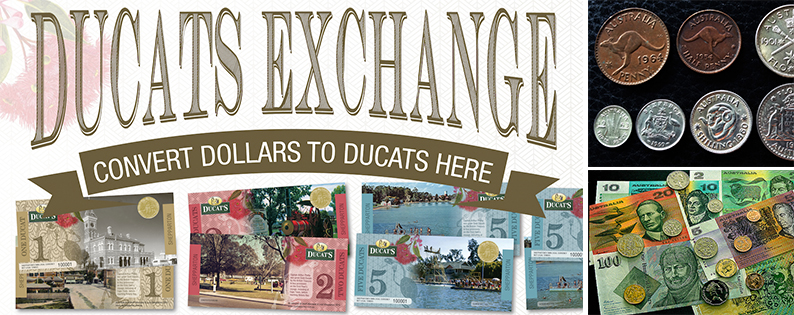50 years ago on Feb 14th, 1966 ... In came the Dollars and Cents and out went the Pounds, Shillings and Pence.
See the video and jingle here.
In Shepparton, in 12 days, we will see our own local currency launched...also an exciting occasion.
Shepparton's own Ducats will compliment our decimal currency to support local businesses in particular.
Final design tweaks are nearly done and then off to a Shepparton printer, where else?
Official Launch: Shepparton City Market - Friday 26th & 27th, in the Mall look out for the Ducat Exchange.
After this event the Ducat Exchange will be at the Lost Shepparton Shop.
Participating businesses here.
More info about our Ducats here.
The Dollar very nearly had another name altogether.
There was a royal uproar when it was announced and many views and opinions were bandied around....
In April 1963, Prime Minister Robert Menzies announced that pounds, shillings and pence were to be ditched in favour of decimal coinage.
In the wake of this bombshell, the whole country had an opinion about what the new money should be named.
The kwid, the champ, the deci-mate and even the hughes were among hundreds of names suggested.
There were other, more tempered possibilities — the austral and the emu had their supporters — but one name was the standout, the obvious and best choice, and on June 5, 1963, Treasurer Harold Holt revealed all.
Our currency would be, he told Parliament and an expectant nation, the royal.
Holt said that after a "close and careful examination", not one of the other possible contenders had been able to beat it.
None "would be fully acceptable to the public", he said.
According to the Treasurer, they lacked "such desirable attributes as brevity and pleasing sound".
Royal was a dignified, distinctive name, Holt said, with the advantage of emphasising Australia's link with the Crown.
These ties went deeper with the minor denominations. The royal was divided into 100 cents, with the coins named after their pre-decimal predecessors — the crown (50 cents), the florin (20 cents) and the shilling (10 cents).
The public, Holt said, would get used to the idea of the royal once the novelty had worn off.
He was dead wrong.
Read more here:
If you are a collector your can order a special set of Ducats (1,2, 5 & 10D notes) from the Lost Shepparton Shop or online at our Tilt (crowdfunding) page. Special deal for all those who order pre-launch.
See the video and jingle here.
In Shepparton, in 12 days, we will see our own local currency launched...also an exciting occasion.
Shepparton's own Ducats will compliment our decimal currency to support local businesses in particular.
Final design tweaks are nearly done and then off to a Shepparton printer, where else?
Official Launch: Shepparton City Market - Friday 26th & 27th, in the Mall look out for the Ducat Exchange.
After this event the Ducat Exchange will be at the Lost Shepparton Shop.
Participating businesses here.
More info about our Ducats here.
The Dollar very nearly had another name altogether.
There was a royal uproar when it was announced and many views and opinions were bandied around....
In April 1963, Prime Minister Robert Menzies announced that pounds, shillings and pence were to be ditched in favour of decimal coinage.
In the wake of this bombshell, the whole country had an opinion about what the new money should be named.
The kwid, the champ, the deci-mate and even the hughes were among hundreds of names suggested.
There were other, more tempered possibilities — the austral and the emu had their supporters — but one name was the standout, the obvious and best choice, and on June 5, 1963, Treasurer Harold Holt revealed all.
Our currency would be, he told Parliament and an expectant nation, the royal.
Holt said that after a "close and careful examination", not one of the other possible contenders had been able to beat it.
None "would be fully acceptable to the public", he said.
According to the Treasurer, they lacked "such desirable attributes as brevity and pleasing sound".
Royal was a dignified, distinctive name, Holt said, with the advantage of emphasising Australia's link with the Crown.
These ties went deeper with the minor denominations. The royal was divided into 100 cents, with the coins named after their pre-decimal predecessors — the crown (50 cents), the florin (20 cents) and the shilling (10 cents).
The public, Holt said, would get used to the idea of the royal once the novelty had worn off.
He was dead wrong.
Read more here:
If you are a collector your can order a special set of Ducats (1,2, 5 & 10D notes) from the Lost Shepparton Shop or online at our Tilt (crowdfunding) page. Special deal for all those who order pre-launch.

 RSS Feed
RSS Feed